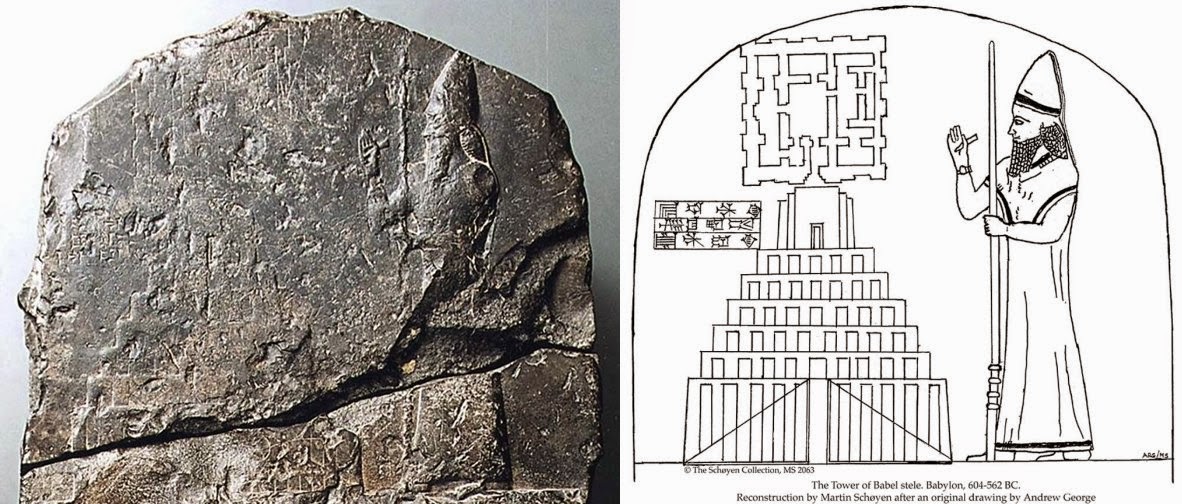
Tower of Babel Stele From Time of Nebuchadnezzar
As we continue to look at the ancient foundations of human history one may ask, “What is the benefit of doing so?” It is not uncommon for a school age child to question the value of their history lessons. They may see little practical benefit for their daily life. How will the study of history help them to get a good paying job, find a spouse, acquire the house of their dreams, or help them to deal with the issues of everyday life?
Such disregard for the value of historical studies should not be found among Christians. A brief moment of contemplation will reveal that the Bible is itself a historical book. The most recent of its writings are two millennia old. The oldest of its writings are between 3,000 – 4,000 years old. The Bible provides an account of Yahweh’s historical dealings with mankind, beginning with the first parents of the human race. Yahweh evidently thought it important that we have an accurate record of man’s history, one that is told from His perspective. The Holy Spirit inspired men of old to record each detail in the Bible for our benefit, that we might walk in wisdom and understanding.
You may ask, “How will understanding ancient Babel aid me as a disciple of Christ today?” The answer is found in recognizing that Babel, or Babylon as it became known, has never ceased to exist. It continues to this day. Not only is this city named in the first book of the Old Testament, but it appears in the last book of the New Testament as well.
Babylon is the first city to be named in the Bible. It is associated with rebellion against God, which is why Yahweh confused the language of men there and scattered them throughout the earth. Babylon has always stood as a symbol of Satan’s kingdom in the same way Zion stands as a symbol of Yahweh’s kingdom. In Genesis we read of the founding of Babel, but now at the end of this age we are observing Babylon come to a fulness of maturity. Her abominations, and rebellion against God, are more in evidence today than at any time in man’s history. For this reason, it is of value for us to turn our attention to Babel, man’s first city, and discover aright the history of that infamous place.
There is a connection between the zodiac we have been studying and ancient Babel. It was at Babel that the stellar prophecy of Yahweh was distorted into an idolatrous religion. At Babel the holy was made profane. Now the entire world is filled with the spiritual corruption whose inception was at Babel. Many ignorant men and women, not understanding the true history of man and his interactions with Yahweh, have imagined vain things. Some assert that there are religions older than that set forth in the Bible which recognizes Yahweh as the Creator of all things. These religions ultimately trace back to Babel, revealing that they are merely corruptions, and a departure from, the true faith of Adam and his descendants. Those who account the mystery religions of Babylon as of greater antiquity than Judaism or Christianity base their claims upon a misapprehension of history.
When I was in my early twenties I attended a local college in my home state of Georgia. During my first year of classes I was required to take a psychology course. The man teaching the course was an atheist and many of his lectures attempted to prove to students that Christianity had borrowed its major beliefs and teachings from earlier religions, particularly Mithraism. The professor claimed that many of the beliefs of Christianity had been present for centuries in earlier religions. Among the things this professor suggested Christianity borrowed from earlier pagan religions was the teaching of a divine Trinity, the use of the cross as a religious symbol, the idea of a blood sacrifice, and even the teaching of the virgin birth.
The professor was wrong in suggesting that New Testament Christianity had culled its ideas from earlier pagan religions, a matter I pointed out to him in a carefully researched and documented letter. He never once mentioned the New Testament writer’s frequent quotations of the Old Testament. Rather than acknowledge the very evident fact that Christianity’s roots lay in the Hebrew faith of the patriarchs and prophets, he argued for a pagan origination. It is easily demonstrated that every major tenet of the New Testament is foreshadowed and prophesied in the Old Testament. Moses wrote the Pentateuch, the first five books of the Bible, 1,500 years B.C.. This date for the first writings of the Old Testament exceed that of the most ancient date postulated for the origin of Mithraism. Consequently, it is absurd to reject a Hebraic origin of Christianity in favor of a Mithraic one.
My college professor lacked carefulness in his claims. He was apparently parroting the arguments he had heard from other sources, but had spent little time seeking to establish the veracity of the arguments he was setting forth. An Internet search on the words “Mithraism and Christianity” will provide links to many websites that are promulgating similar views to those set forth by my professor thirty years ago. One will find an equal number of Christian apologetics websites that are refuting the claims that Christianity borrowed its teachings from Mithraism.
Despite the apparent overreach and misstatement of my professor, a valid point is raised in his arguments. Many of the teachings, customs, and symbols of Christianity are found in pagan religions that predate the Christian era. One of the reasons for this is that Christianity as it is practiced today has borrowed many customs, symbols, and beliefs from paganism. The church has departed from true apostolic Christianity as set forth in the New Testament of the Bible. Many Christians have never taken the time to examine current church practice and doctrines to differentiate between that which is founded upon the teaching of Yahshua and His apostles and that which results from the practice of syncretism (the act of embracing, and seeking to reconcile, pagan doctrines, customs, and symbols with Christianity).
Examples of syncretism are the observance of the birth of Christ on December 25th at the time of the Winter Solstice; the observance of Easter, the very name of the holiday being the same as the goddess of fertility otherwise known as Eostre, Ishtar, Ashtoreth and Astarte; the observance of Lent; the adoption of Sunday as the Christian Sabbath; the practice of placing obelisks (steeples) on church houses, and many other such departures from the teaching of Christ and His apostles.

Obelisks
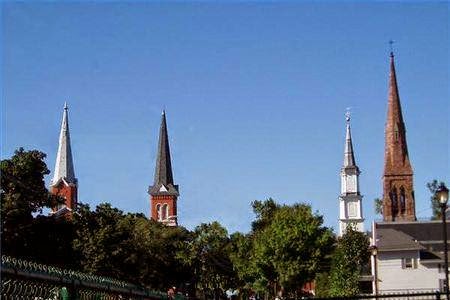
Church Steeples
When all of these things are shown to predate Christianity by centuries, and are plainly demonstrated to be artifacts of pagan religion, the believer who has not separated the faith of the original disciples from the apostate forms of Christianity present today is left with the troubling conclusion that Christianity has borrowed heavily from the very pagan religions it condemns. Christianity’s two most revered holidays are based upon the astronomical observations of Babylonian sun worship, the first occurring at the time of the Winter Solstice (Christmas), and the latter occurring at the time of the Spring Equinox (Easter). Astonishingly, the church has even preserved the name of the pagan goddess of fertility in the observance of its Spring celebration. The name Easter is a form of the Germanic Eostre, the Babylonian Ishtar, the Aramean Astarte, and the Canaanite Ashtoreth who is named as one of the false deities worshiped by pagan cultures in the Old Testament, and which the Israelites so often embraced at the displeasure of Yahweh.
I Kings 11:5
For Solomon went after Ashtoreth the goddess of the Sidonians…
Christians may protest that Easter actually has its origin in the Hebrew Passover, but the fact of the matter is that this Christian high holy day is an unrighteous merging of the holy and the profane. Baskets of grass and bonnets of flowers, colored eggs, and Easter bunnies are all symbols of fertility that are traceable back to the pagan worship of the Babylonian goddess of fertility, the Queen of Heaven. Arising early to participate in a “Sunrise service” on “Easter” morning is equally pagan in origin. The New Testament reveals no practice of Christ, His apostles, or the early disciples observing holidays at the Winter Solstice and Spring Equinox, but pagan religions have done so from ancient times. The date of the Jewish Passover is determined in an entirely different manner from that of Easter, and it has distinct rites and symbols that are not present in Easter traditions.
Though the Bible does not state plainly when Christ was born, clues in the gospels point to an Autumn birth that likely occurred during the Feast of Tabernacles. Early Christians in Rome began celebrating the birth of the Son of God in December to appease current practice among sun worshipers of holding a great celebration at the time of the Winter solstice. The Romans worshiped the sun under the name Sol Invictus, “the unconquered sun.” In late December they observed Dies Natalis Solis Invicti, a holiday that translates as “the birthday of the unconquered sun.”
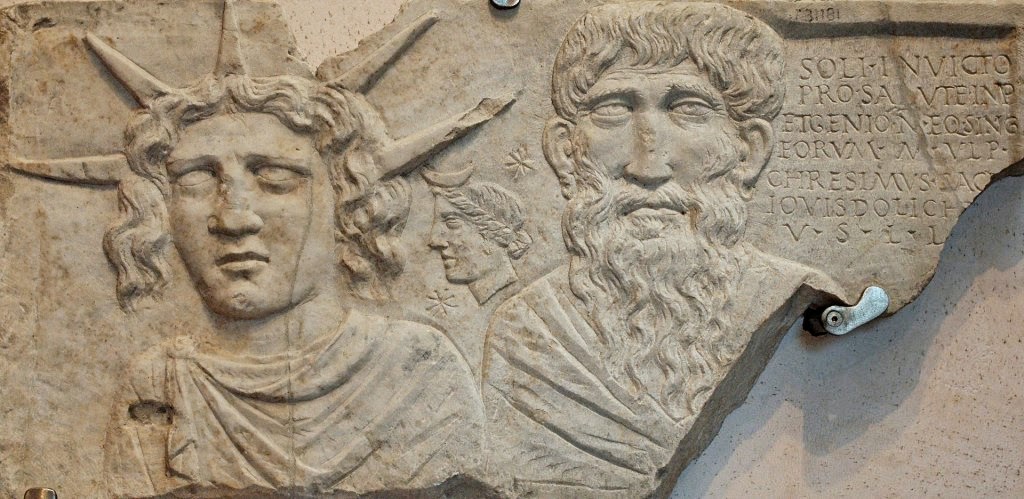
Sol Invictus Stele, circa 150-200 A.D.
Note the sun rays circling the head of Sol Invictus. A female moon goddess can be seen next to Sol Invictus, bearing a crescent moon on her head. The similarity between Sol Invictus and the Statue of Liberty standing in New York’s harbor is not coincidental. The Statue of Liberty was a gift from the Freemasons of France to the United States. Freemasonry is one of many human institutions that have kept alive the ancient Babylonian teachings, symbols, and customs.
If we strip away all the pagan trappings that have been incorporated into Christianity in the past 2,000 years, we will find that the customs, traditions, and doctrines of the apostles bear little resemblance to what is observed in Christianity today. Nevertheless, there are still basic tenets of the apostolic faith that did appear in pagan religions that pre-date the New Testament by centuries. Following are some examples.
Divine Trinity
One of the most ancient civilizations that arose in the Fertile Crescent of Mesopotamia was Sumeria. Historian H.S. Hooke informs us that over 4,000 years ago the Sumerians believed in a divine trinity. Anu was the great god of heaven, the “Father,” and the “King of the Gods.” Enlil was the creator god and god of the earth. Ea was the god of the waters and “lord of wisdom.” One can perceive some parallels to the God of the Bible in this Sumerian trinity. Yahweh is the “Father” and His throne is in the heavens. His Son, Yahshua created all things. The Holy Spirit reveals to man the mind, or “wisdom” of God, and the first mention of the Holy Spirit in the Bible speaks of Him as brooding over the waters of the earth.
The Sumerians were conquered by the Assyrians, and later by the Neo-Babylonians. The concept of a trinity of gods continued with them.
The ancient Babylonians recognised the doctrine of a trinity, or three persons in one god – as appears from a composite god with three heads forming part of their mythology, and the use of the equilateral triangle, also, as an emblem of such trinity in unity…
[Source: Thomas Dennis Rock, The Mystical Woman and the Cities of the Nations, 1867, pp. 22-23]
Alexander Hislop, wrote the following in his book The Two Babylons.
In the unity of that one, Only God of the Babylonians there were three persons, and to symbolize that doctrine of the Trinity, they employed… the equilateral triangle, just as it is well known the Romish Church does at this day.”
In ancient Babylon the original triad of gods appears to have been Nimrod, his wife Semiramis, and Semiramis’ son Tammuz who was declared to be Nimrod reborn. Similarly, we find a divine trinity in Egypt. Various Egyptian deities have been linked together. Isis, Horus, and Seb are suggested by some to be the origin of the Roman Catholic symbol “IHS.” Osiris, Isis, and Horus are also linked together, as are Amun, Re, and Ptah. In Greece Zeus, Poseidon, and Adonis formed a triad of gods, and in Rome it was Jupiter, Neptune, and Pluto. The Phoenicians worshipped Ulomus, Ulosuros and Eliun. In Germanic nations there was the trinity of Woden, Thor and Frigga (or Freya). In India we also find the divine triad of Vishnu, Brahma, and Shiva. Many other examples from other cultures and religions could be cited.
Virgin and Child
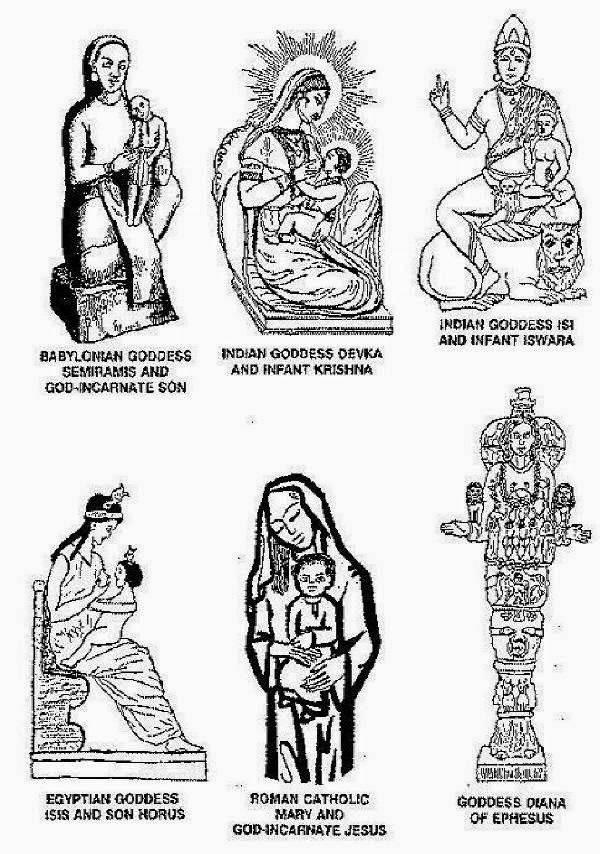
Babylonian Semiramis and Tammuz
Indian Devka and Krishna
Indian Isi and Iswara
Egyptian Isis and Horus
Roman Catholic Mary and Jesus
The prototypical pagan image of mother and child is that of the Babylonian Semiramis and Tammuz. After Semiramis’ husband Nimrod was slain, he was declared to have ascended to heaven where he became the sun-god. Semiramis claimed to have been impregnated by the rays of the sun-god, giving birth to Tammuz who was fantastically claimed to be Nimrod reborn. In this we see an early type of a woman becoming pregnant without human intercourse, bearing a divine seed. This concept of a mother and her divine child has been present in many religions throughout the world. Alexander Hislop writes:
The Babylonians in their popular religion supremely worshiped a goddess mother and a son who was represented in pictures and images as an infant or a child in his mother’s arms. From Babylon this worship of mother and child spread to the ends of the earth. In Egypt, the mother and child were worshiped under the names Isis and Osiris. In India, even to this day, as Isi and Iswara; in Asia as Cybele and Deoius; in pagan Rome as Fortuna and Jupiter-puer “Jupiter the boy”; in Greece as Ceres, the Great Mother, with the babe at her breast, or as Irene, the goddess of Peace, with the boy Plutus in her arms, and even in Thibet, in China and Japan…
The pagan worship of a divine mother and child are mentioned in the Bible. The woman bears many names, at times being referred to as “the queen of heaven.” This is a title the Roman Catholics ascribe to Mary, the mother of Christ. Perhaps the most ancient name for this divine mother’s son among pagan religions is that of Tammuz.
Jeremiah 7:18
The children gather wood, and the fathers kindle the fire, and the women knead dough to make cakes for the queen of heaven…
Ezekiel 8:14-16
Then He brought me to the entrance of the gate of Yahweh’s house which was toward the north; and behold, women were sitting there weeping for Tammuz. He said to me, “Do you see this, son of man? Yet you will see still greater abominations than these.” Then He brought me into the inner court of Yahweh’s house. And behold, at the entrance to the temple of Yahweh, between the porch and the altar, were about twenty-five men with their backs to the temple of Yahweh and their faces toward the east; and they were prostrating themselves eastward toward the sun.
I believe many Christians in reading the Old Testament accounts of the idolatrous practices in which God’s chosen people engaged, perceive the actions of the Israelites to be an outrageous departure from the true, pure, and holy worship of Yahweh. Yet, few Christians perceive how this idolatrous practice continues in the church today. Babylon continues to spread its leaven into the religious life of God’s chosen people. Ezekiel’s mention of the women of Israel weeping for Tammuz finds its modern parallel in the Roman Catholic observance known as Lent that begins on Ash Wednesday. Placing ashes on one’s head has been a sign of mourning from ancient times. When the ashes are applied in the form of a cross, or letter “t,” they are duplicating the ancient symbol for Tammuz.

(Note the symbol on the back of the priest’s garment is also the symbol of Tammuz.)
Nowhere in the New Testament do we read of Christ’s apostles or the early church engaging in such rituals. These customs entered into the church through the Roman Catholic practice of syncretism. When Emperor Constantine declared Rome to be a Christian empire, it was determined that some accommodation had to be made for the millions of pagan citizens who were disingenuously declared to be Christians. Rome’s solution was to “Christianize” the ancient pagan practices, providing alternative explanations that made them less objectionable to true Christians. Instead of observing the birth of the unconquerable sun on December 25th, the church would observe the birth of the Son of God on the same date. Instead of forty days of mourning for Tammuz leading up to the observance of Easter at the Spring Equinox, the church would observe a period of forty days of sober reflection preceding the commemoration of the death, burial, and resurrection of Christ.
There existed 2,000 years ago, as there exists today, significant numbers of professing Christians who justify the practice of syncretism. Even when the pagan origins of their traditions and symbols are pointed out, they cling tenaciously to them. Nevertheless, this unrighteous merging of the holy and the profane is a practice that Yahweh condemns. Speaking of the role of the Levitical priests, the prophet Ezekiel recorded the following words of God.
Ezekiel 44:23
“Moreover, they shall teach My people the difference between the holy and the profane, and cause them to discern between the unclean and the clean.”
The apostles of the New Testament also commanded all Christians to separate themselves from idolatrous practices and all that pertains to Satan.
II Corinthians 6:14-18
Do not be bound together with unbelievers; for what partnership have righteousness and lawlessness, or what fellowship has light with darkness? Or what harmony has Christ with Belial, or what has a believer in common with an unbeliever? Or what agreement has the temple of God with idols? For we are the temple of the living God; just as God said, “I will dwell in them and walk among them; And I will be their God, and they shall be My people. Therefore, come out from their midst and be separate,” says the Lord. “And do not touch what is unclean; And I will welcome you. And I will be a father to you, and you shall be sons and daughters to Me,” says the Lord Almighty.
When Christians condemn the Israelites for their idolatry, while practicing the same rites and customs, embracing the same symbols of sun worship, and observing holidays on the same dates as the pagan religions, they are either blind, or they are guilty of justifying what God condemns. Is it any wonder that in the last book of the Bible we find the Spirit of God calling Christians to come out of Babylon? Babylon has overtaken the church.
Revelation 18:4
And I heard another voice from heaven, saying, “Come out of [Babylon], my people, that you may not participate in her sins and that you may not receive of her plagues…”
For more on this subject, see the series titled Syncretism.
http://www.heart4god.ws/index_htm_files/Syncretism.pdf
Once a Christian separates themselves from the corruptions of Babylon that have infiltrated the church in the last 2,000 years, they will find that there are far fewer similarities between Christian doctrines and practice and ancient false religions. It is much more difficult for college and university professors to make a case for a pagan origin of Christianity once believers separate between the holy and the vile. Nevertheless, some basic tenets of Christianity can be found in ancient religions going as far back as Babel. How is this possible?
The preceding chapters of this writing have demonstrated that Yahweh has from ancient times made known His plan for the redemption of mankind. The first communication of the divine plan for man’s salvation was spoken to Adam and Eve immediately after they had sinned. Yahweh informed them that a Seed would come forth from the woman that would crush the serpent’s head, signifying a destruction of Satan’s authority and power over mankind. We observed that further specifics of God’s plan were revealed to have been communicated to Adam and his descendants, for Abel’s offering of lambs of the flock as a sacrifice to Yahweh reveal that the principle of a substitutionary sacrifice had been made known by God. We are told that Abel’s offering was one of “faith” (Hebrews 11:4). Faith always arises out from a word of God (Romans 10:17, Galatians 3:2, 5).
Furthermore, in the preceding chapters evidence was provided to substantiate that the stars of the heavens themselves have been pouring forth speech night after night, declaring the glories of God from the very foundation of the earth. The gospel message has been displayed in the constellations of the heavens from the beginning of man’s history. This by itself is sufficient to account for the appearance of various Christian doctrines and symbols appearing in pagan religions from ancient times. If the body of Christ would separate itself from idolatrous practices, and begin to teach the knowledge of the great antiquity of the gospel message, young believers would be better prepared to resist attacks on their faith that are inevitable in a world under the dominion and influence of Satan.
The corruption of the prophetic message of the gospel began at once after the flood of Noah’s day. Noah was a righteous man, pleasing to God. Sin, however, is ever restless, and it did not take long before Noah’s descendants began to fall into that same error that so marked mankind before the flood. The apostle Paul speaks of man’s descent into vain thoughts and sinful behavior in the following passage.
Romans 1:18-25
For God’s [holy] wrath and indignation are revealed from heaven against all ungodliness and unrighteousness of men, who in their wickedness repress and hinder the truth and make it inoperative. For that which is known about God is evident to them and made plain in their inner consciousness, because God [Himself] has shown it to them. For ever since the creation of the world His invisible nature and attributes, that is, His eternal power and divinity, have been made intelligible and clearly discernible in and through the things that have been made (His handiworks). So [men] are without excuse [altogether without any defense or justification], [Psalms 19:1-4.] Because when they knew and recognized Him as God, they did not honor and glorify Him as God or give Him thanks. But instead they became futile and godless in their thinking [with vain imaginings, foolish reasoning, and stupid speculations] and their senseless minds were darkened. Claiming to be wise, they became fools [professing to be smart, they made simpletons of themselves]. And by them the glory and majesty and excellence of the immortal God were exchanged for and represented by images, resembling mortal man and birds and beasts and reptiles. Therefore God gave them up in the lusts of their [own] hearts to sexual impurity, to the dishonoring of their bodies among themselves [abandoning them to the degrading power of sin], because they exchanged the truth of God for a lie and worshiped and served the creature rather than the Creator, Who is blessed forever!
[Amplified Bible]
Many of the images found in the Zodiac were corrupted into objects of worship. Did not the Israelites elicit the wrath of God as hey formed the image of a golden calf in the wilderness, an act repeated some centuries later when Jeroboam constructed graven images of a golden calf at Dan and Bethel? How many nations have worshiped images of the dragon, another symbol found among the constellations? Yet the most insidious and intractable corruptions are those that relate to the mother and child pictured in Virgo, and in Coma. The virgin that gives birth has been repeatedly corrupted, beginning with Semiramis and Tammuz, and spreading through all the nations. It is observed most profoundly today in the idolatrous Roman Catholic veneration of Mary as the queen of heaven. Do not be deceived, brothers and sisters. Nowhere in the Bible do we find any justification for Mary worship. When some foolish woman among the multitudes who thronged the Son of God first proposed that Mary be venerated, Yahshua cut short such a suggestion, exposing it to be contrary to the will of God.
Luke 11:27-28
One of the women in the crowd raised her voice, and said to Him, “Blessed is the womb that bore You, and the breasts at which You nursed.” But He said, “On the contrary, blessed are those who hear the word of God, and observe it.”
It is little wonder that John was astonished when he was shown a vision of the Great Harlot of Babylon, the corrupt church that would arise to replace apostolic Christianity. It must have come as a shock and tremendous grief to see Babylon overtake and supplant a pure devotion to Christ.

This is Babylon!
Let us return to the origin of this idolatrous practice among the descendants of Noah after the flood. The 10th chapter of Genesis records the table of nations, those families of the earth that descended from Noah’s three sons. Significantly, the first kingdom, and the first city, are mentioned in this passage, being linked to a descendant of Ham whose name was Nimrod. (Ham was the son of Noah who exposed the nakedness of his father when Noah had gotten drunk on wine and uncovered himself inside his tent. Ham had four sons, and Noah specifically cursed the lineage of Ham’s son Canaan. Nimrod was a grandson of Ham, but he was not of the lineage of Canaan.)
Genesis 10:1-12
Now these are the records of the generations of Shem, Ham, and Japheth, the sons of Noah; and sons were born to them after the flood… And the sons of Ham were Cush and Mizraim and Put and Canaan. And the sons of Cush were Seba and Havilah and Sabtah and Raamah and Sabteca… Now Cush became the father of Nimrod; he became a mighty one on the earth. He was a mighty hunter before Yahweh; therefore it is said, “Like Nimrod a mighty hunter before Yahweh.” And the beginning of his kingdom was Babel and Erech and Accad and Calneh, in the land of Shinar. From that land he went forth into Assyria, and built Nineveh and Rehoboth-Ir and Calah, and Resen between Nineveh and Calah; that is the great city.
Because Nimrod is directly linked to Babel, that city that has become a symbol of defiance against Yahweh, standing in direct opposition to Zion, the city of God, it is well that we investigate further the identity of this man. Some have supposed that the information provided about Nimrod in this passage is offered as a mark of praise for a mighty man among the descendants of Noah. This interpretation has a number of problems, however. One of them is Nimrod’s connection to Babel. Babel/Babylon is everywhere recognized in Scripture as a wicked city and a symbol of Satan’s earthly rule. It was at Babel that mankind gathered together in defiance of Yahweh to build themselves a tower and a city to make a name for themselves, and to keep from being scattered upon the face of the earth. This was in contradiction to Yahweh’s command to Noah and his sons to “fill the earth” (Genesis 9:1).
It is significant that the first mention of a human kingdom is in reference to Nimrod and to Babel. Until that time all men had been free of human rulers, knowing only the government and rule of God. Now they had a man to rule over them, and in this is a manifestation of the first anti-christ. The word anti-christ means “in place of Christ.” An anti-christ is an usurper. It is one who takes upon themself a role that God occupies. In becoming a ruler over other men, Nimrod was usurping God’s role. Those who submitted to Nimrod’s rule were casting aside Yahweh’s rule over their lives. We see this principle explained in the days when Israel demanded a king.
I Samuel 8:4-9
Then all the elders of Israel gathered together and came to Samuel at Ramah; and they said to him, “Behold, you have grown old, and your sons do not walk in your ways. Now appoint a king for us to judge us like all the nations.” But the thing was displeasing in the sight of Samuel when they said, “Give us a king to judge us.” And Samuel prayed to Yahweh. And Yahweh said to Samuel, “Listen to the voice of the people in regard to all that they say to you, for they have not rejected you, but they have rejected Me from being king over them. Like all the deeds which they have done since the day that I brought them up from Egypt even to this day – in that they have forsaken Me and served other gods – so they are doing to you also.”
When the Bible states that Nimrod was a mighty hunter before Yahweh, the actual wording states that Nimrod was a mighty hunter in the face of Yahweh. The Jewish rabbis understood the phrase “in the face of Yahweh” to mean “in defiance of Yahweh.” It is no contradiction to suggest that Nimrod’s act of establishing his own rule over man was an act of rejection and defiance in the face of God. A further clue regarding Nimrod’s rebellion against Yahweh is found in a suggested meaning of his name. Although the etymology of the name Nimrod is much debated, one possible derivation that I have found of interest is the following.
In 1920, J.D. Prince also suggested a possible link between the Lord (Ni) of Marad and Nimrod. He mentioned how Dr. Kraeling was now inclined to connect Nimrod historically with Lugal-Banda, a mythological king mentioned in Poebel, Historical Texts, 1914, whose seat was at the city Marad.
[Source: http://en.wikipedia.org/wiki/Nimrod]
The name Ni-Marad is translated “Lord of Marad.” Marad is much more than the name of an ancient Chaldean city. The Hebrew word for “rebel” is “marad.”
Numbers 14:9
Only do not rebel (Hebrew – marad) against Yahweh…
James Strong provides the following definition for this Hebrew word.
OT:4775
marad (maw-rad’); a primitive root; to rebel:
This Hebrew word that is used as a verb in Number 14:9 is also used elsewhere as a noun.
Ezekiel 20:38
And I will purge out from among you the rebels (Hebrew – marad), and them that transgress against me…
Bible teacher and author Donald Gray Barnhouse offered the following translation of the verses found in Genesis that relate to Nimrod.
Cush begat Nimrod; he began to be a mighty despot in the land. He was an arrogant tyrant, defiant before the face of the Lord; wherefore it is said, Even as Nimrod, the mighty despot, haughty before the face of the Lord. And the homeland of his empire was Babel, then Erech, then Accad, and Calneh, in the land of Shinar. From this base he invaded the kingdom of Asshur, and built Nineveh, and Rehoboth-Ir, and Calah, and Resin between Nineveh and Calah. These make up one great city.
[Source: The Invisible War, Donald Gray Barnhouse.]
There is much room for interpretation in this passage describing Nimrod. The word that is translated as “mighty” in our English Bibles is the Hebrew “gibbor.” This word is used in a wide range of applications. The giants who were born as the spawn of fallen angels cohabiting with the daughters of men are described as “gibborim,” a plural form of the same word. Some have suggested that Nimrod himself was a giant, and he appears as such in some ancient mythologies. The following image is found in the book The Chaldean Account of Genesis. It is an ancient depiction of Gilgamesh, whom archaeologist and historian George Smith referred to as Izdubar, for he stated that he had not yet phonetically deciphered the Chaldean name he found on the pottery fragments from ancient Nineveh. George Smith was convinced that Izdubar/Gilgamesh was the same as Nimrod of the Bible.
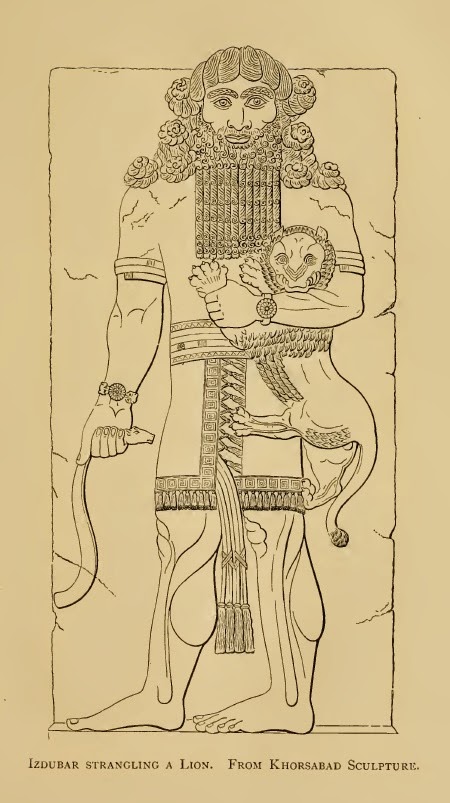
According to this ancient depiction, the figure of Izdubar/Gilgamesh/Nimrod holding a full grown lion would be approximately 20 feet in height. Some have suggested that the Biblical statement that Nimrod began to be a “gibbor” allows for an interpretation of Nimrod as a giant. This, however, strikes me as dubious, for the giants were ALWAYS descendants of angels and women cohabiting. In contrast, we are told that Nimrod is a direct descendant of Noah through his son Ham, and Ham’s son Cush. His lineage is completely human. It is certainly possible that Nimrod was a large and powerful man, but we have no indication that he was a descendant of the Nephilim (fallen ones).
George Smith provides the following evidence to support his belief that the Chaldean Izdubar/Gilgamesh was based upon the historic person the Bible names as Nimrod.
The centre of the empire of Izdubar appears to have lain in the region of Shinar, at Babylon, Akkad, Erech, and Nipur, and agrees with the site of the kingdom of Nimrod, according to Genesis X. 8, 9, 10, where we read : “And Cush begat Nimrod: he began to be a mighty one in the earth. He was a mighty hunter before the Lord: wherefore it is said, even as Nimrod the mighty hunter before the Lord. And the beginning of his kingdom was Babel, and Erech, and Accad, and Calneh, in the land of Shinar.” All these cities were ultimately within the dominion of Izdubar, whose character as hunter, leader, and king corresponds with that of Nimrod, and the name of Shamas, or Samas the sungod, who is most probably represented as his father, may read Kusu (Cush), the same name as that of the father of Nimrod…
The two passages already quoted from Genesis afford the only reliable information with respect to
Nimrod outside the cuneiform inscriptions. According to Genesis Nimrod was a ” son of Cush,” that is a Cushite, or Ethiopian, and he distinguished himself as a mighty hunter, his prowess being so great that his name passed into a proverb. He afterwards became king, commencing his reign in Shinar or Babylonia, and still later extended his empire into Assyria, where he laid the foundations of that state by the foundation of the four leading cities, Nineveh, Calah, Rehobothair, and Resen. The fame of Nimrod is again alluded to in the Bible, where Assyria is called the land of Nimrod…
I was entirely in the dark until I discovered the Deluge tablet in 1872, I then conjectured that the hero whose name I provisionally called Izdubar was the Nimrod of the Bible, a conjecture which I have strengthened by fresh evidence from time to time…
My own opinion that he was the hero I have hitherto called Izdubar was first founded on the discovery that he formed the centre of the national historical poetry, and was the hero of Babylonian cuneiform history, just as Nimrod is stated to have been in the later traditions.
I subsequently found that he agreed exactly in character with Nimrod; he was a giant hunter, according to the cuneiform legends, who contended with and destroyed the lion, tiger, leopard, and wild bull or buffalo, animals the most formidable in the chase in any country. He ruled first in Babylonia over the region which from other sources we know to have been the centre of Nimrod’s kingdom. He extended his dominion to the Armenian mountains, the boundary of his late conquests according to tradition, and one principal scene of his exploits and triumphs was the city of Erech, which, according to Genesis, was the second capital of Nimrod.
[Source: The Chaldean Account of Genesis, George Smith]
The reader at this point may remark that there is a great difference between the words “mighty hunter” and “mighty despot.” What is the proper rendering of the Genesis account of Nimrod? In Hebrew the words are “gibbor tsayid.” The Hebrew word gibbor indicates that which is mighty in a wide range of applications. The word is used to describe the giant offspring of angels and women, as well as descendants of Adam who were mighty in battle or strength. The word is even applied to God, for He too is mighty. The Hebrew word tsayid is understood to relate to the process of catching or killing a wild animal (or figuratively man). It expresses the idea of lying in wait as a huntsman would in pursuing his quarry. The word is at times used as a reference to the hunter, while at other times it is a reference to the wild game that he has slain for food. This same word is used when the Bible speaks of Esau, the son of Isaac, being a skilled huntsman (tsayid), and it is used to speak of the venison (tsayid) that Esau brought to his father.
Some have suggested that Nimrod was more than a mighty hunter of wild animals. They contend that he was a hunter of men, being skilled in warfare. In fact, some Bible translations describe Nimrod as a mighty warrior and mighty hunter.
Genesis 10:8-9
Cush was the father of Nimrod, who grew to be a mighty warrior (gibbor) on the earth. He was a mighty hunter (gibbor tsayid) before the Lord; that is why it is said, “Like Nimrod, a mighty hunter (gibbor tsayid) before the Lord.”
[New International Version]
Genesis 10:8-10
Cush was also the ancestor of Nimrod, who was the first heroic warrior (gibbor) on earth. Since he was the greatest hunter (gibbor tsayid) in the world, his name became proverbial. People would say, “This man is like Nimrod, the greatest hunter (gibbor tsayid) in the world.”
[New Living Translation]
The two translations above obviously reveal the beliefs of the translators and have strayed from a strict literal interpretation. There is nothing in the Hebrew wording to denote that Nimrod was considered a “heroic” figure, nor is the word “warrior” found in the Hebrew text. The same criticism could be leveled at Barnhouse’s translation, for there is no mention of Nimrod being a “despot,” or a “tyrant.” Such ideas may be deduced from other evidence within or without the pages of Scripture, but a strict literal rendering of the original Hebrew manuscripts does not lead the translator to these interpretations.
There is much historical evidence to lend support to the idea of Nimrod being a mighty “hunter,” for it was quite common for Chaldean monarchs to be depicted in conflict with a wild animal. These images helped shape public opinion about the ruler, suggesting that they were virile, strong, and fearless.
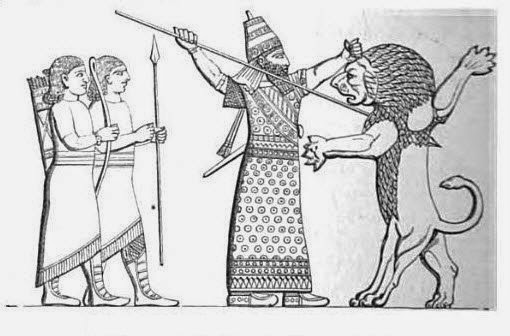
A Chaldean King Slaying a Lion
(Image from The Five Great Monarchies of the Ancient World, George Rawlinson)
It is likely that Nimrod was the prototype for the courageous Chaldean monarch, and others sought to emulate his fame through similar exploits. George Rawlinson reports that lion hunts were popular among the Babylonian and Assyrian kings. The heroic image of a mighty hunter was certainly a popular one among the ancient Chaldeans as the Epic of Gilgamesh demonstrates.
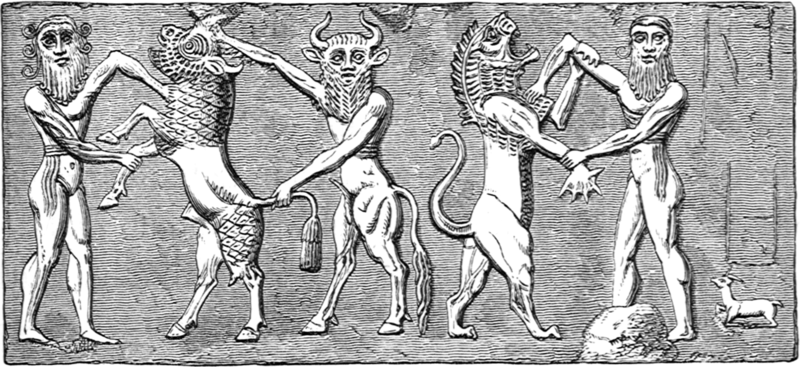
Gilgamesh Battling the Bull and the Lion
In the Epic of Gilgamesh, the lead character is described as two thirds divine and one part man. This glorification of a man into a deity parallels the history of Nimrod. Alexander Hislop in his book The Two Babylons, published in 1858, traces the origin of the Babylonian mystery religion back to Nimrod and his wife Semiramis. The subtitle to Hislop’s book is The Papal Worship Proved to be the Worship of Nimrod and His Wife. If Hislop is correct (I believe he is), and Nimrod is the prototype and origin of that idolatrous religion now recognized as Roman Catholicism, then Nimrod becomes a character of great relevance to Christians today. The book of Revelation describes Babylon, the Great Harlot, in the following way.
Revelation 17:4-6
And the woman was clothed in purple and scarlet, and adorned with gold and precious stones and pearls, having in her hand a gold cup full of abominations and of the unclean things of her immorality, and upon her forehead a name was written, a mystery, “BABYLON THE GREAT, THE MOTHER OF HARLOTS AND OF THE ABOMINATIONS OF THE EARTH.” And I saw the woman drunk with the blood of the saints, and with the blood of the witnesses of Yahshua.
This description fits well with the character of Roman Catholicism. The Bishop’s and Cardinals of the Roman church adorn themselves in purple and scarlet.
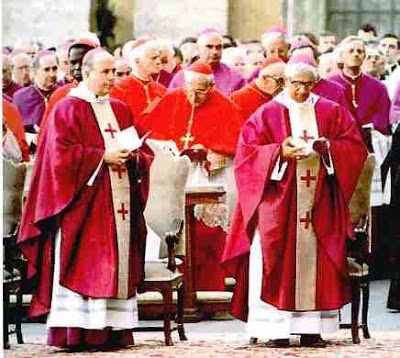
Even the Pope arrays himself in scarlet.
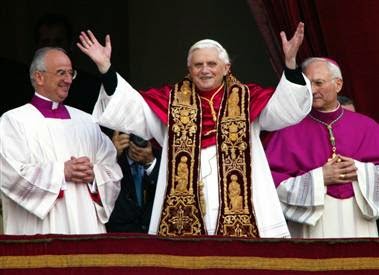
Pope Benedict and Cardinals
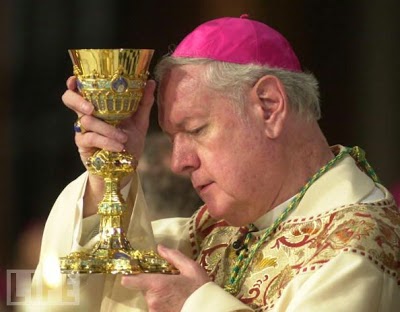
“Having a cup of abominations in her hand…”
Unlike the humility of Christ, the apostles, and the early disciples, the Romish church has grown fabulously rich in the material goods of this world. Everywhere one turns gold, silver, precious stones, and rich clothing and fabrics are found. The apostasy of the Roman Catholic church is so extensive that it has become an abomination, more pagan that Christian. The abominations of Roman Catholicism stem from her pretending to be “Christian” when in fact her rites, symbols, holy days, vestures, and even her buildings proclaim that she is the guardian and promoter of the ancient solar worship.
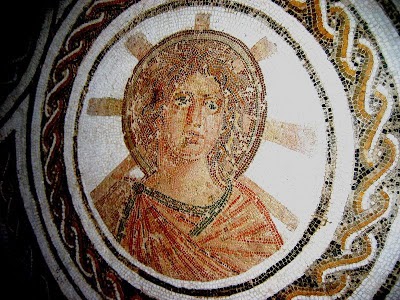
Images of Christ, the apostles and saints are depicted throughout Roman Catholicism with a nimbus, or solar halo, around the head. The picture above could easily pass as a figure of the Roman Catholic Christ, or one of the apostles, but in fact it is an image of Apollo, the Roman sun-god. The Catholic church has brought obelisks from Egypt and set them on the grounds of her most venerated sites. The central feature of the plaza of Saint Peter’s Basilica at the Vatican is an Egyptian obelisk that was originally constructed in Heliopolis, Egypt. The very name Heliopolis means “city of the sun.”
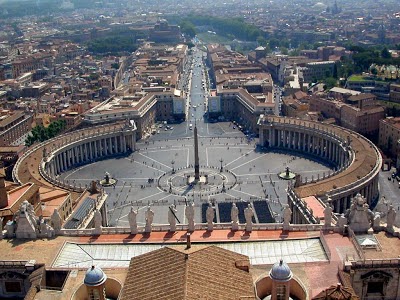
The “square” at the Papal Basilica of Saint Peter is actually circular, arranged like a great sun dial with the Egyptian obelisk at its center. The sun worship of Babel passed on to Egypt and from there to Rome where the Roman Catholic church has kept it alive to this day.
Saint Peter’s Basilica is NOT the mother church of Roman Catholicism. This dubious honor belongs to the Papal Archbasilica of St. John Lateran in Rome. Outside of this building is an even larger obelisk that was likewise relocated from Egypt. It is called “the Lateran Obelisk.”
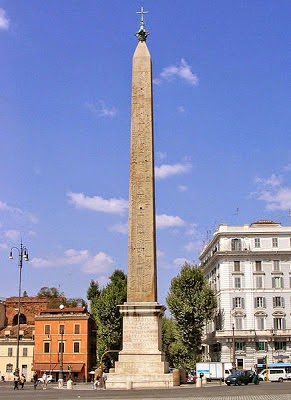
Lateran Obelisk
The word obelisk means “shaft of Bel (Baal).” The meaning is two-fold. It is a reference to a shaft of light from the sun-god, as well as being a symbol of the reproductive organ of the same being. Examine the New Testament as thoroughly as you like and no discovery will be made of Christ or His apostles ever using the obelisk as a symbol of the faith. This symbol has from earliest antiquity always been associated with sun worship. It is a symbol venerated today by Freemasons, and has become an ubiquitous symbol in city squares and to mark the graves of Freemasons.
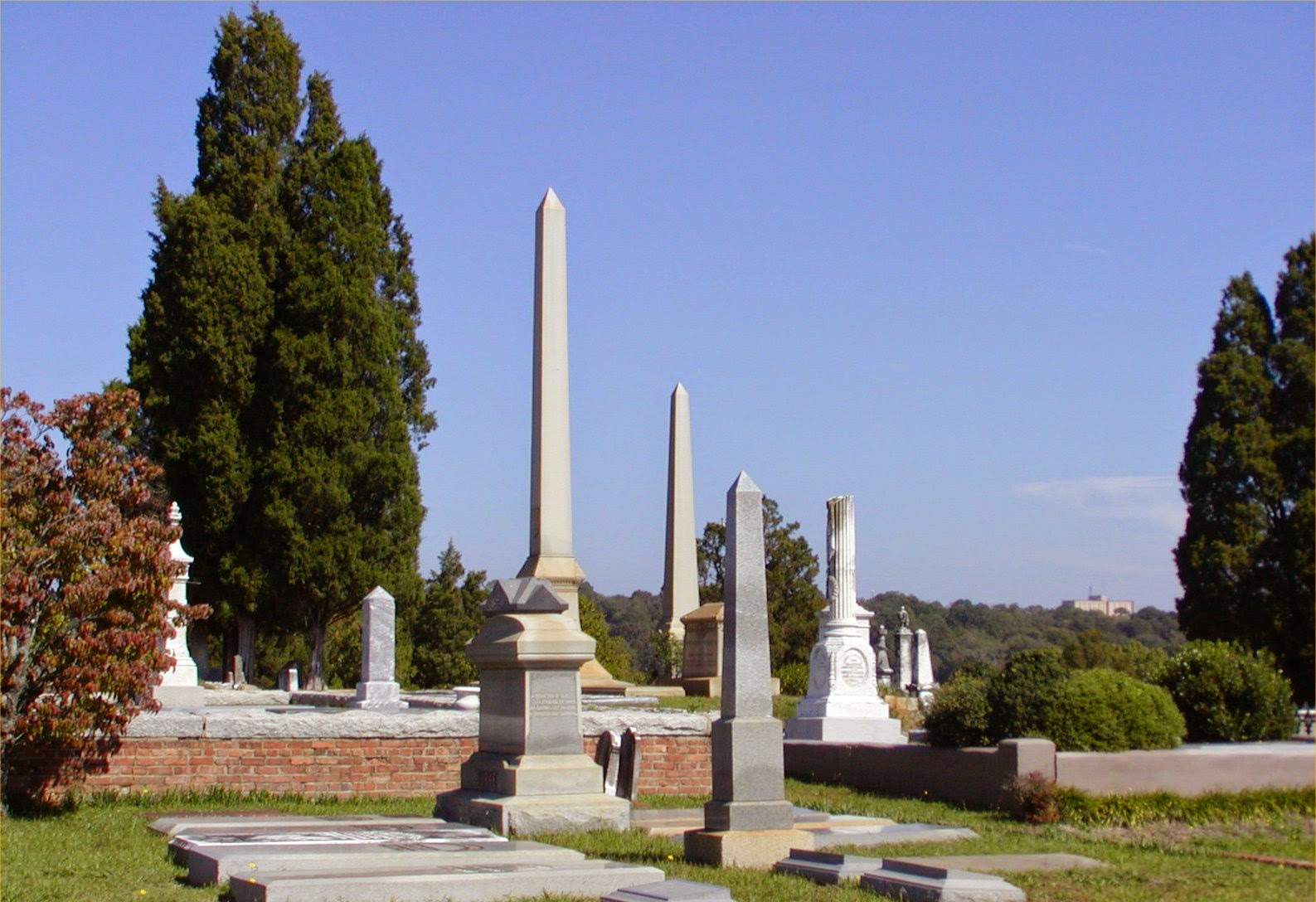
Obelisks at Rose Hill Cemetery – Macon, Georgia
For some years the Father led me to reside in Macon, Georgia. While there I learned much about Freemasonry and its Babylonian connection. The name Macon is the French word for “Mason.” Macon, Georgia is truly a Masonic city. It is located between 32 and 33 degrees north latitude, the numbers 32 and 33 being the two highest degrees in Scottish Rite Freemasonry. The website for the chamber of commerce of the city of Macon, Georgia states that the town was laid out upon the same design as the ancient city of Babylon, incorporating wide streets and tree lined boulevards.
Yet, I believe there is an unusual historical connection that influenced the Masonic founders of Macon to locate their city where they did. Within the limits of the city there is a National Monument called The Ocmulgee Indian Mounds. The early Indians who dwelt in this place are recognized as “mound builders.” The mounds they built served a similar function as the ziggurats, or stepped pyramids, of the Babylonians. On top of the mound was erected a temple, a place of worship. Following is an architect’s drawing of the Ocmulgee Great Temple Mound.
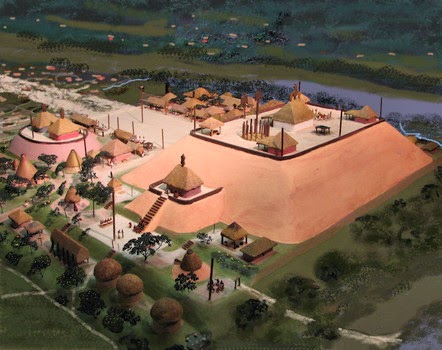
Ocmulgee Great Temple Mound
I have been out to this site numerous times. Following are a couple images of what this site looks like today. The first photo is an aerial shot. You can see the great mound at the upper right hand side of the photograph. There are no structures atop the mound today. It is just a level plateau.
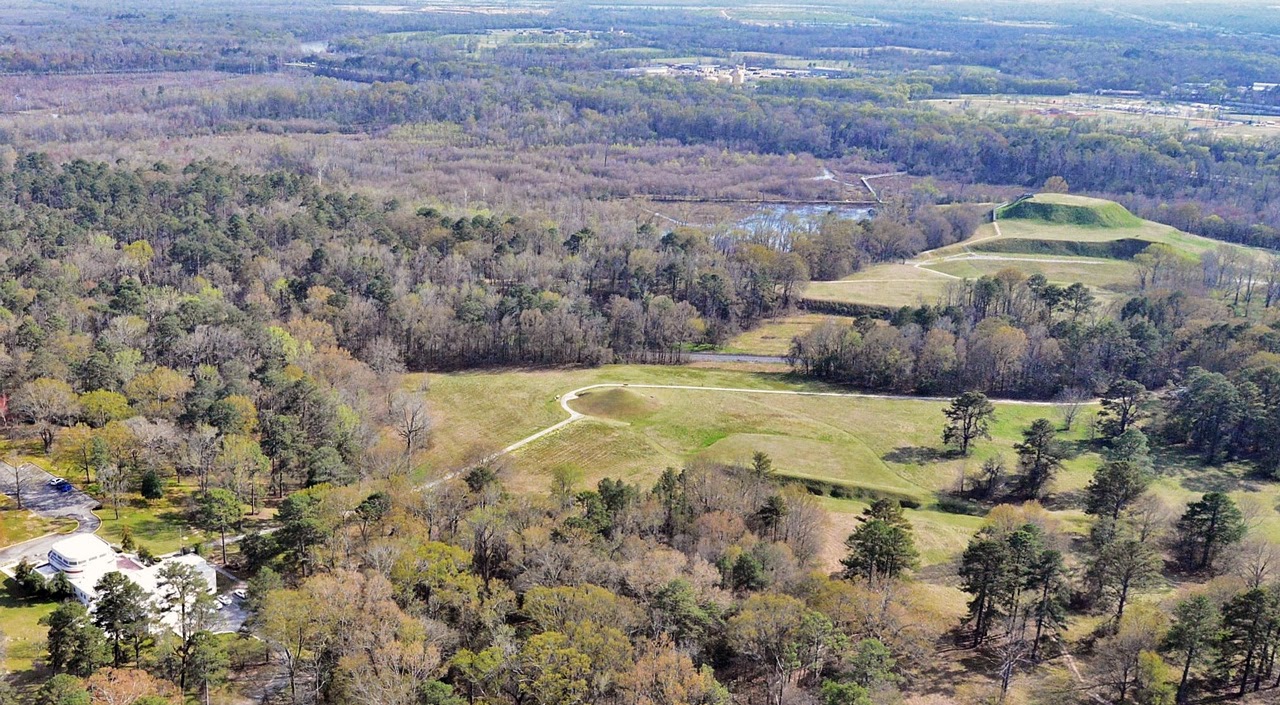
(Click on image to view larger)
The next photo shows the same mound from ground level looking up.
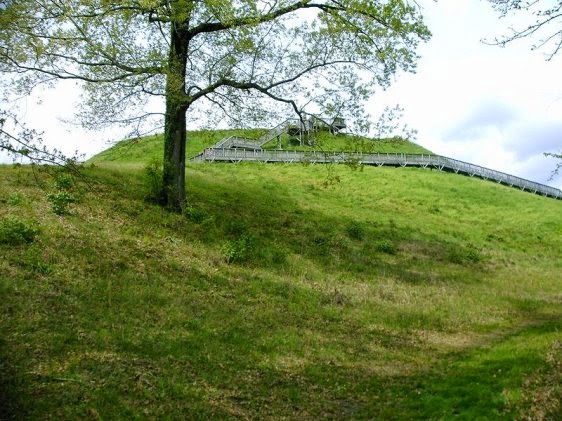
Great Temple Mound
Standing atop the mound, a person can see the central section of downtown Macon, Georgia.
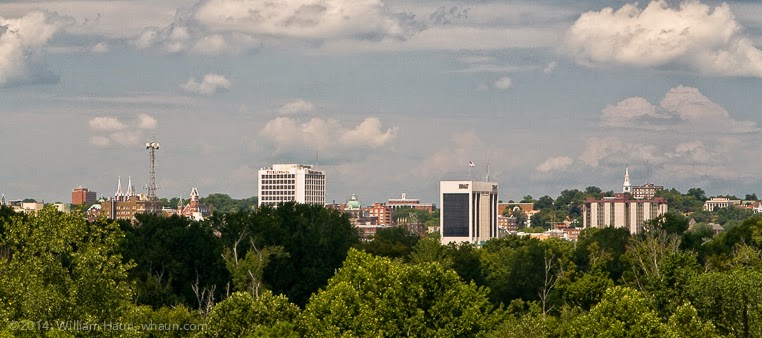
View From Top of Mound
The similarities between Macon, Georgia and ancient Babel are not coincidental. They are intentional. The Bible tells us that Nimrod founded the city of Babel, and the next chapter (Genesis 11) informs us that the people conspired together to build up the city and a tower.
Genesis 11:4
And they said, “Come, let us build for ourselves a city, and a tower whose top will reach into heaven, and let us make for ourselves a name; lest we be scattered abroad over the face of the whole earth.”
The common rendering of the verse above is not literally accurate. The words “will reach into” do not appear in the original Hebrew manuscripts. A more literal translation would read, “Come, let us build for ourselves a city, and a tower whose top the heavens…” The translators have inserted the words “will reach into” as they believed this is the thought being conveyed. It is a point that is debated, however. Some Bible scholars and historians believe that a very different meaning was implied. There is substantial evidence to argue for a translation that would denote that the tower itself, especially its topmost level, was adorned with the figures of the heavens. E.W. Bullinger’s Companion Study Bible includes the following note on Genesis 11:4.
may reach. No ellipsis here. Heb. “And its top with the heavens,” i.e. with the Zodiac depicted on it, as in ancient temples of Denderah and Esneh in Egypt.
Bullinger shares his view that this tower had the zodiac depicted upon it. This is a view supported by others. In the 1850s, William Goode delivered a set of talks referred to as the Warburtonian Lectures which were published some years later. William Goode was Dean of Ripon, a Senior Cleric’s position in the Church of England. In the notes to the published copy of his fourth lecture, Goode re-prints the account of Lieutenant General Chesney who had visited the ruins of Babylon in present day Iraq on several occasions.
Nowhere have I seen the desolating effects of time so vividly brought before me as when gazing on the remains of this once mighty city; and the realization of the prophet’s words, ‘Babylon the great is fallen,’ recur to the mind with thrilling force… About five miles SW of Hillah, the most remarkable of all the ruins, the Birs Nimrud of the Arabs arises to a height of 153 feet above the plain from a base covering a square of 400 feet, or almost four acres. It was constructed of kiln-dried bricks in seven stages to correspond with the seven spheres (Joseph’s Note – the five known planets, the sun and the moon), their respective colors corresponding with the planets to which they were dedicated: the lowermost black, the colour of Saturn; the next orange, for Jupiter; the third red, for Mars, and so on. These stages were surmounted by a lofty tower, on the summit of which we are told were the signs of the zodiac and other astronomical figures; thus having (as it should have been translated), ‘a representation of the heavens,’ instead of ‘a top which reached into heaven.’ This temple… was restored by Nebuchadnezzar, whose name it bears on the bricks and on the cylinders deposited at its angles.
It seems clear to me that this ruin came within the ruins of ancient Babylon, which, according to Herodotus, embraced an area of 120 stadia, or fourteen miles each way, which would be at least five times the size of London; but this of course includes gardens, which are often of considerable extent, parks, orchards, and even fields, as in most Eastern cities.
[Source: Fulfilled Prophecy, A Proof of the Truth of Revealed Religion: Being the Warburtonian Lectures for 1854-1858, by the Very Reverend William Goode, Dean of Ripon]
Birs Nimrud is one of a number of ancient ruins in the vicinity of ancient Babel that archaeologists and Bible historians have proposed as the site of the Tower of Babel. Birs Nimrud translates into English as “the mound of Nimrod.” There was not much more than a large mound at this location in the days of King Nebuchadnezzar II, the Babylonian king who conquered Jerusalem. Nebuchadnezzar lived approximately 1,700 years after the original Tower of Babel was built. Nebuchadnezzar, perceiving this to be a site of great antiquity and religious importance, built over the ancient mound, encapsulating it within a new structure that arose around and above it. Wikipedia provides the following information on Birs Nimrud.
Many legal administrative and astronomical texts on cuneiform tablets have originated at Borsippa and have turned up on the black market. Archives began to be published in the 1980s. An inscription of Nebuchadrezzar II, the “Borsippa inscription,” tells how he restored the temple of Nabu, “the temple of the seven spheres,” with “bricks of noble lapis lazuli.” that must have been covered with a rich blue glaze, surely a memorable sight. The Austrian archeologists have determined that Nebuchadnezzar’s ziggurat encased the ruins of a smaller tower from the second millennium BCE. When it was completed it reached a height of 70 meters, in seven terraces; even in ruin it still stands a striking 52 meters over the perfectly flat plain…
An inscribed foundation stone has been recovered, which details Nebuchadnezzar’s plan to have the Borsippa ziggurat built on the same design as that at Babylon, of which only the foundation survives. Nebuchadnezzar declared that Nabu’s tower would reach the skies…
[Source: http://en.wikipedia.org/wiki/Birs_Nimrud, emphasis added]
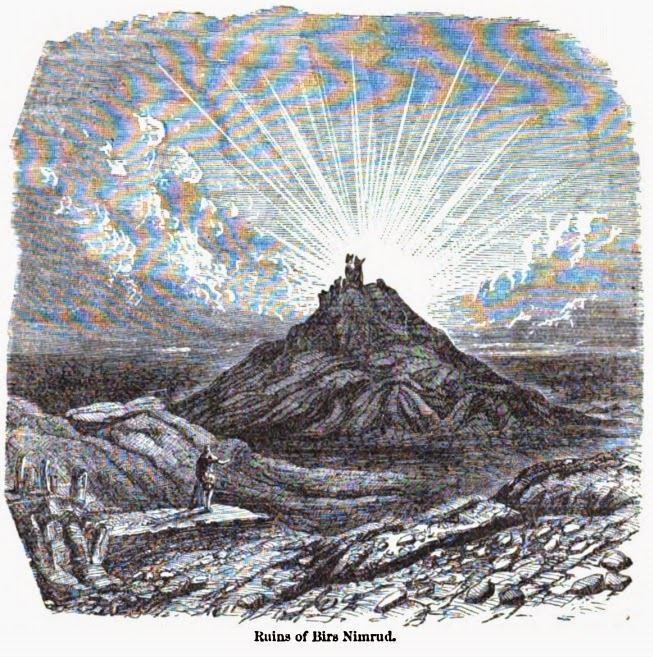
Drawing of the Ruins of Birs Nimrud from the 1800s
In Nebuchadnezzar’s day, this temple mound/tower was known as “the temple of the seven spheres.” The ancients recognized seven spheres, or planets, in the heavens. These are the five planets visible to the unaided eye, along with the sun and the moon. That the tower was dedicated to the seven spheres, or heavenly bodies, reveals the ancient relationship between tower building and astronomy/astrology among the Babylonians.
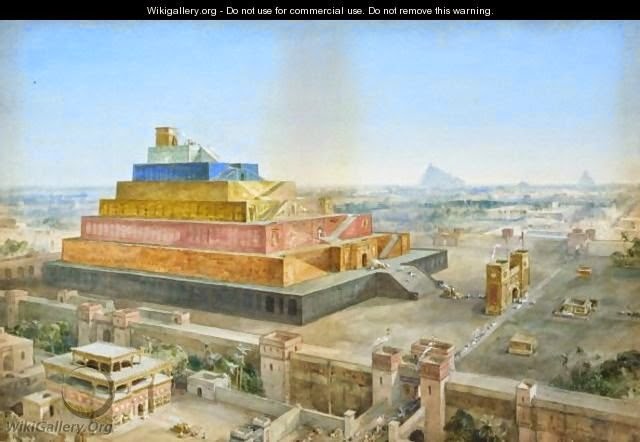
Birs Nimrud Restoration
The Wikipedia article states that Nebuchadnezzar adopted a design for the reconstruction of the temple of the seven spheres that was based upon an even larger stepped tower, or ziggurat that lay closer to the center of the city of Babylon. This greater tower is Etemenanki which translates as “House of the platform of Heaven and Earth.” Less remains of Etemenanki today than remains of Birs Nimrud. Some have proposed that Etemenanki is the site of the original tower of Babel.
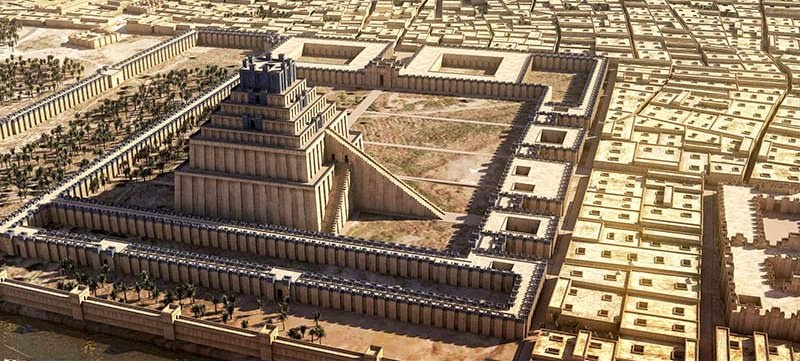
Etemenanki
The image above is an artist’s rendering of Etemenanki in the city of Babylon found on the website http://www.kadingirra.com/babylon.html. Following is another image from the same webpage.
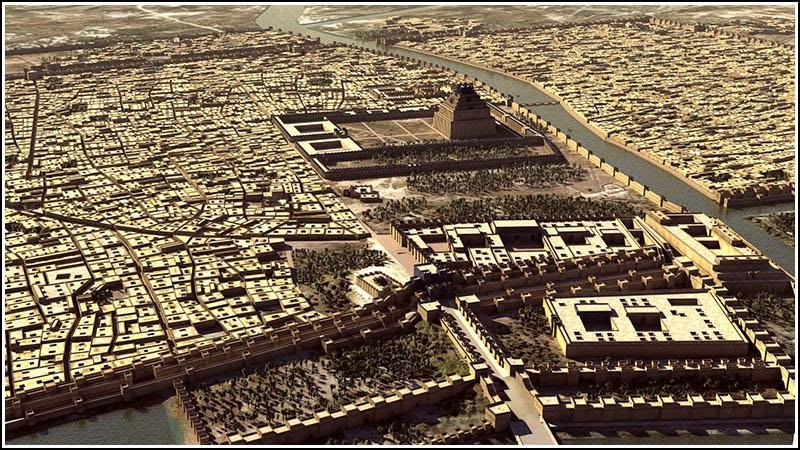
When I look at this, I see clear parallels to Macon, Georgia and the Ocmulgee Great Temple Mound. It too lies along a river. Satan has kept alive the ancient sun worship from the time of Nimrod and the original tower of Babel. There is a very intriguing small mound into which the park visitor can walk at the Ocmulgee Indian Mounds. This smaller mound was a gathering place that has fifty molded seating places and the image of a great eagle on the ground. There is a narrow entryway that an adult has to stoop down to enter. Precisely at the time of the spiring equinox, the sun shines directly down the narrow entry and falls upon the image of the eagle inside.
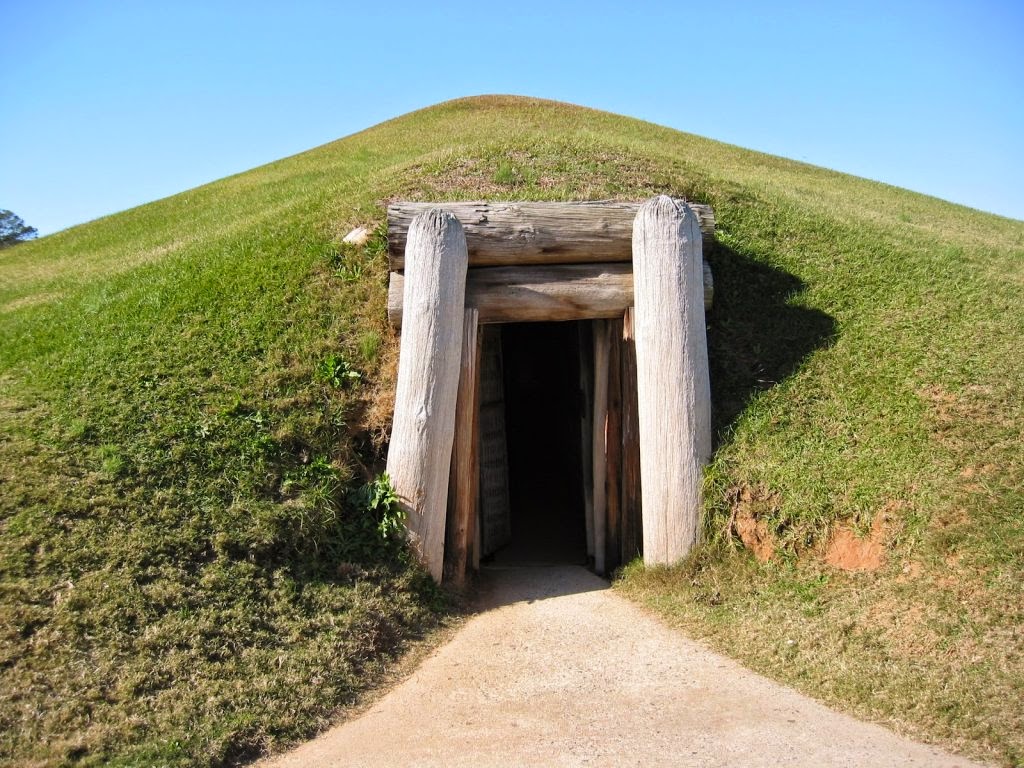
Exterior of Ocmulgee Meeting Mound
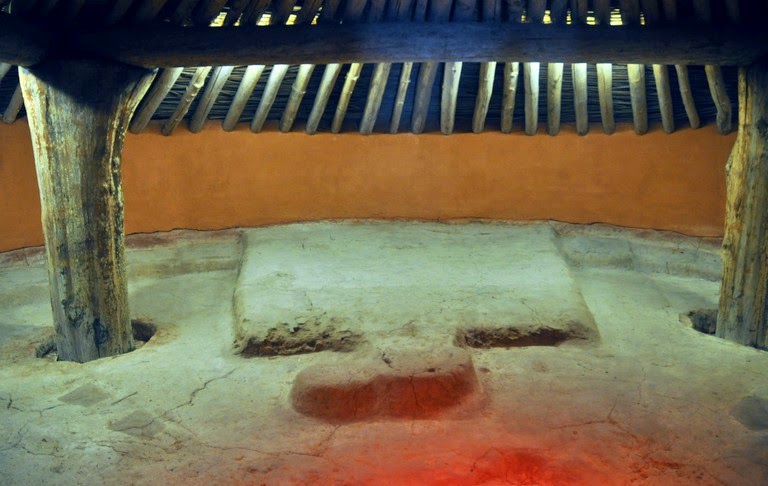
Interior of Ocmulgee Meeting Mound
This structure that is dated to seven or eight centuries before the founding of the United States of America bears the national symbol of America (the eagle) and has precisely fifty seats corresponding to the fifty United States of America. Something remarkable appears to be indicated here, as if Satan had planned from long ago for this land, and the nation that would one day occupy it, to be a key instrument in the reconstruction of Babylon upon the earth. America is the great melting pot of many nations, and within America lies the headquarters for the United Nations, the precursor to a restored one world government modeled upon ancient Babel. As such, Nimrod serves as a prototype for the antichrist to come.
An event that has struck me as a further parallel between this Macon monument and ancient Babel is that a “Guided Astronomy Walk” has been featured there. Participants meet at the Visitor Center and a park ranger guides them to the Great Temple Mound where they can use telescopes to view the planets, the moon, and the stars.
Nebuchadnezzar II ruled Babylon from 605-562 BC. It was he who destroyed Jerusalem (Zion) and took God’s people captive (those whom he did not slay.) There is certainly something spiritually significant indicated here, for spiritual Babylon is Satan’s kingdom, and it has frequently ravaged God’s chosen people whether they be the Hebrews, or the church of Christ. Today, the church spiritually resembles Jerusalem in ruins. The walls of the city are broken down giving Satan and his servants free entrance among the people of God. The treasures of the people of God have been looted, taken to Babylon to be placed in the temple of idols. Indeed, that which most people perceive as Christianity today is a house of idolatry that has an abominable admixture of the holy and the profane.
Whether Birs Nimrud, or Etemenanki are the actual site of the Tower of Babel, I believe it is reasonable to conclude that the original tower’s design is reflected in these structures. Both of them were stepped towers whose design, dimensions, and appearance have been described by ancient historians. Following are the dimensions of Etemenanki taken from a tablet that described the ziggurat.
1st step 300ft by 300ft 110ft high
2nd step 260ft by 260ft 60ft high
3rd step 200ft by 200ft 20ft high
4th step 170ft by 170ft 20ft high
5th step 140ft by 140ft 20ft high
6th step ? 20ft high?
7th step 70ft by 80ft 50ft high
(The scribe omitted the dimensions of the sixth step but its height was probably twenty feet.)
The temple situated on the very top of the ziggurat would have risen 300 feet above the plain. Etemenanki, like Birs Nimrud, was reconstructed in the days of King Nebuchadnezzar and his father Nabopolassar. It is believed that the tower that existed at this site was previously built in the 2nd millennium B.C., placing it in near proximity to the construction of the tower of Babel. This date estimate is based upon a poem fragment from an Assyrian Creation Epic (Enuma Elis) that mentions a “ziqqurrat apsî elite,” which translates as “the upper ziqqurrat of the Apsû.” This description is believed to be a reference to Etemenanki.
In 689 B.C. the Assyrian King Sennacherib invaded the land and is reported to have destroyed Etemenanki. The Babylonian Kings Nabopolassor and his son Nebuchadnezzar II spent 88 years rebuilding the city of Babylon. Following the pattern of the original inhabitants of Babel, the Babylonian kings continued to be tower builders. An inscription remains in Nebuchadnezzar’s own words describing his reconstruction of Etemenanki and Birs Nimrud at Borsippa. The first paragraph below refers to Etemenanki, and the second paragraph to Birs Nimrud.
The tower, the eternal house, which I founded and built. I have completed its magnificence with silver, gold, other metals, stone, enameled bricks, fir and pine. The first which is the house of the earth’s base, the most ancient monument of Babylon; I built and finished it. I have highly exalted its head with bricks covered with copper.
We say for the other, that is, this edifice, the house of the seven lights of the earth the most ancient monument of Borsippa. A former king built it, (they reckon 42 ages) but he did not complete its head. Since a remote time, people had abandoned it, without order expressing their words. Since that time the earthquake and the thunder had dispersed the sun-dried clay. The bricks of the casing had been split, and the earth of the interior had been scattered in heaps. Merodach, the great god, excited my mind to repair this building. I did not change the site nor did I take away the foundation. In a fortunate month, in an auspicious day, I undertook to build porticoes around the crude brick masses, and the casing of burnt bricks. I adapted the circuits, I put the inscription of my name in the Kitir of the portico. I set my hand to finish it. And to exalt its head. As it had been done in ancient days, so I exalted its summit.
[Source: http://en.wikipedia.org/wiki/Etemenanki]
These words reveal that it was believed in Nebuchadnezzar’s day that the ruins at Birs Nimrud were the original Tower of Babel, a tower that was left with the top incomplete due to the people having abandoned its building when their language was confused. Nebuchadnezzar’s testimony does little to settle the question of whether the Scriptures are communicating the people’s intent to build a tower whose top reached into the heavens, or a tower whose top revealed the heavens. Nebuchadnezzar in one statement declares that his reconstruction of the “tower would reach the skies,” yet he also constructed each of the seven levels to correspond to one of “the seven spheres” of the heavens, and Herodotus reported to have seen the tower and described it as having the constellations of the zodiac adorning its summit.
Whatever the actual meaning that is intended in the Scriptures, there is a definite link between Nimrod, Babel, its famed Tower, and the idolatrous worship that spread from there to all parts of the world. We will look further at the character of this religion, and its presence in all ages and all parts of the globe in the next chapter.
Heart4God Website: http://www.heart4god.ws
Parables Blog: www.parablesblog.blogspot.com
Mailing Address:
Joseph Herrin
P.O. Box 804
Montezuma, GA 31063


Hi Joseph, just passing through. Thank you for the exceptionally high-quality photos of the modern-day Ocmulgee mounds. I read your post about having to transition your site so as a fellow webmaster and a token of gratitude for aiding this student’s studies, I thought I would point out that the images on the post are not clickable as they were on the old site. Hope that helps as you continue to transition your archives. (: